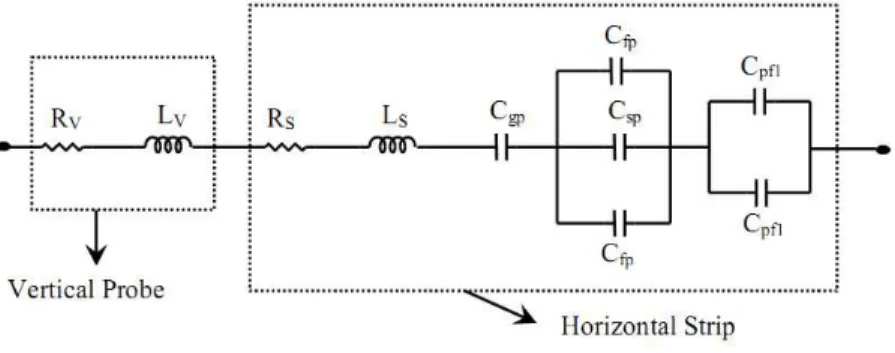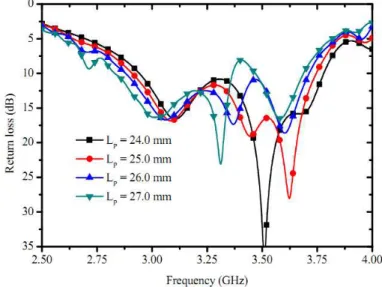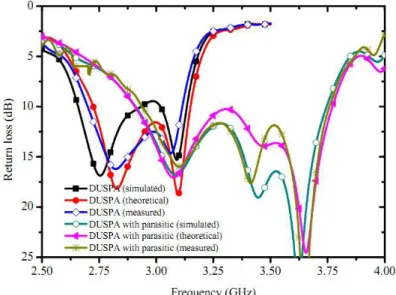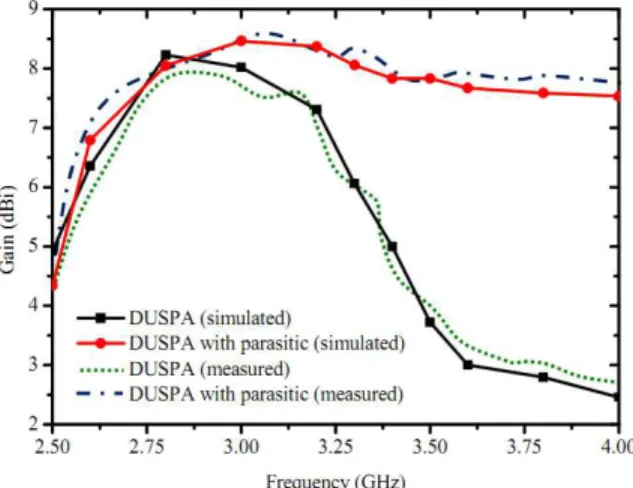Brazilian Microwave and Optoelectronics Society-SBMO received 26 Dec. 2016; for review 29 Dec 2016; accepted 26 May 2017 Brazilian Society of Electromagnetism-SBMag © 2017 SBMO/SBMag ISSN 2179-1074
Dual U
-
Slot Loaded Patch Antenna with a
Modified L
-
Probe Feeding
Rakesh N. Tiwari1, Prabhakar Singh2, Binod Kumar Kanaujia3
Department of Electronics and Communication Engineering, Raffles University, Neemrana, Rajasthan, INDIA-301705, Email: srakeshnath@gmail.com
Department of Physics, Galgotias University, Greater Noida, Uttar Pradesh, INDIA-201308 Email: prabhakarsingh3@gmail.com
3School of Computational and Integrative Sciences, Jawaharlal Nehru University, New Delhi, INDIA-110067 Email: bkkanaujia@yahoo.co.in
Abstract— In this paper, a modified
L-strip fed patch antenna is
theoretically analyzed for wideband applications. Dual U-shaped
slots are incorporated in the radiating patch and a maximum
bandwidth of 16.93% (2.65 GHz to 3.14 GHz) is achieved.
Further, when two parasitic elements are used, antenna
bandwidth improves up to 25.89% (2.90 GHz to 3.77 GHz). The
maximum gain of dual U-slotted patch and with parasitic
elements is 8.23 dBi and 8.46 dBi respectively. Antenna
parameters are calculated by CST Microwave studio and
equivalent circuit model theory is presented. The proposed
antenna is fabricated and the measured results compare well
with the theoretical as well as simulated results.
Index Terms— Dual U-slot patch antenna; modified L-probe; multilayer patch antenna; gap coupled patch antenna; parasitic elements.
I. INTRODUCTION
With the rapid development and attractive solution for various wireless communication systems and
demands of their applications, compact and wideband antenna designs have been given immense priority
[1], [2]. In this process, various methods were used to improve the bandwidth such as by loading the slots
of different size and shape, etching notches and introducing discontinuities in the radiating patch as well
as in the ground plane [3], [4]. There are several structures reported to improve the antenna characteristics
such as E-shaped [5], [6], C-shaped, U-slot loaded and modified L-strip [7-9]. Different feeding methods
also increase the antenna bandwidth such as proximity feed patch, asymmetric CPW fed patch antennas
[10], [11]. Substrate with low dielectric constants, multilayer structures and use of air gaps between the
dielectric layers increases the impedance bandwidth and gain of the microstrip antennas [12-14]. Besides
Brazilian Microwave and Optoelectronics Society-SBMO received 26 Dec. 2016; for review 29 Dec 2016; accepted 26 May 2017 Brazilian Society of Electromagnetism-SBMag © 2017 SBMO/SBMag ISSN 2179-1074
[16]. Apart from that some other types of parasitic element design such as slot type, shorted strip type etc
[17], [18] can improve the antenna bandwidth and gain.
The present paper reports a radiating structure to study the antenna bandwidth, gain, efficiency and the
radiation pattern. Dual U-slot is incorporated in the radiating patch such that one U-slot is lying within
another U-slot forming dual U-slot loaded patch antenna (DUSPA). Further, to increase the bandwidth,
two parasitic elements are used above this DUSPA. Both designs are fed by modified L-probe. All the
calculations are made by using CST Microwave studio. Also, a theoretical analysis for the proposed
antenna is developed based on cavity model. The proposed design is fabricated and various antenna
parameters are measured. The details of antenna design and results are discussed in the following
sections.
II. ANTENNA DESIGN AND GEOMETRICAL CONFIGURATION
The top view and the side view of the proposed antenna configuration are shown in Fig. 1. The radiating
patch is printed on lower side of a substrate of thickness h2. On the other side a conducting strip of
dimension ls × ws is printed. The relative position of the strip is at a distance ‘p’ from the edge of the
patch. This strip is excited by center conductor of coaxial probe. The patch is suspended at a height h1
from the ground plane. An inverted U-slot of dimensions L2 × W2 with width d1 is etched within another
U-slot of dimensions L1 × W1 with same width d1. This DUSPA which is printed on the lower side of the
substrate of thickness h2, is energized by a conducting strip printed on the upper side of this substrate.
Further two parasitic elements of dimensions Lp × Wp separated by gap D are placed at thickness h3 from
the conducting strip. These parasitic patches are excited by electromagnetic coupling with DUSPA. A
detail design specification is given in Table-1.
Brazilian Microwave and Optoelectronics Society-SBMO received 26 Dec. 2016; for review 29 Dec 2016; accepted 26 May 2017 Brazilian Society of Electromagnetism-SBMag © 2017 SBMO/SBMag ISSN 2179-1074
(b)
Fig. 1. Geometry of the proposed antenna (a) Top view (b) Side view.
The proposed antenna is fabricated on Rogers RT duriod substrate (dielectric constant 2.2) with ground
plane dimensions (Wg × Lg) 80 × 52 mm2 (Fig. 2).
Brazilian Microwave and Optoelectronics Society-SBMO received 26 Dec. 2016; for review 29 Dec 2016; accepted 26 May 2017 Brazilian Society of Electromagnetism-SBMag © 2017 SBMO/SBMag ISSN 2179-1074
III. THEORETICAL INVESTIGATION
(a) Analysis of modified feeding: Modified L-probe feeding can be analyzed into two parts i.e. vertical
probe and horizontal strip.
Fig. 3.Equivalent circuit of modified L-probe.
Vertical Probe: Vertical probe can be analyzed as series combination of resistance Rv and inductance Lv,
and can be given as [19].
RV=√
πfμ σ
dp (h1+ h2) (1)
where µ = permeability of the probe conductor, f = frequency in GHz, dp = diameter of probe
and
LV = 2.032(h1+ h2) [ln(h1+h2)
dp + 0.2235
dp
(h1+h2)+ 1.193] nH (2)
Horizontal Strip: A series combination of distributive resistance Rs and inductive Ls is developed due to
horizontal conducting strip and can be given as [20].
LS= 0.2(h1+ h2) [ln {2(h1+h2)
ws+ts } + 0.2235 {
ws+ts
(h1+h2)} + 0.5] in (nH) (3)
RS= 4.13 × 10−3(h1+ h2)(w√fρ0
s+ts) (f in GHz) (4)
here, ws = width of strip, ts= thickness of strip, ρ0 = ratio of specific resistance of strip and copper.
The distributive capacitance Csp between horizontal strip and the radiating patch can be given as
Csp=εrε0lsws
Brazilian Microwave and Optoelectronics Society-SBMO received 26 Dec. 2016; for review 29 Dec 2016; accepted 26 May 2017 Brazilian Society of Electromagnetism-SBMag © 2017 SBMO/SBMag ISSN 2179-1074
Since the open ends of the horizontal strip above the radiating patch will have fringing field, so the
effective length of the strip is increased. The increment of length will cause some extra capacitance which
is fringing capacitance and it can be calculated as
Cf=leεes
−1/2
cZ0 (6)
here,
le=
0.412h(εes+ 0.3) (ws
h + 0.264)
(εes− 0.258) (ws
h + 0.8)
in which 𝜀𝑒𝑠 is effective dielectric constant for the material under conducting strip [19]. The fringing
capacitance Cfp between open end of the strip and the radiating patch is calculated by putting the substrate
height h = h2 and the fringing capacitance Cfg can be given by putting h = (h1 + h2). The fringing
capacitance Cpf1 between the parasitic elements and the strip is calculated by putting h = h3. The entire
feeding acts as a series L-C resonant element and connected in series with the radiating patch. The
impedance of this modified L-probe can be calculated using Fig. 3 as
ZLS= Rv+ jωLv+ Rs+ jωLs+ 1
jωCgp+ 1
jωCeq (7)
where,
Ceq=2C2Cpf1(2Cfp+ Csp)
pf1+ 2Cfp+ Csp
(b) Analysis for DUSPA: The value of capacitance C1, inductance L1 and resistance R1 for a rectangular
patch can be given as [20].
C1=2(hε0εeLW 1+ h2)cos
−2(πls
W)
L1 =ω21C 1
R1=ωQCr 1
where, L = length of the patch, W = width of the patch, f1 = resonance frequency, 𝑙𝑠 = feed point location,
Brazilian Microwave and Optoelectronics Society-SBMO received 26 Dec. 2016; for review 29 Dec 2016; accepted 26 May 2017 Brazilian Society of Electromagnetism-SBMag © 2017 SBMO/SBMag ISSN 2179-1074
Qr= c√
εe
4f1(h1+ h2)
where, c = velocity of light, f1= design frequency, εe = effective permittivity of the medium
εe=εrs+1
2 +
εrs−1
2 (1 +
10(h1+h2)
L )
−1/2
(8)
in which, εrs can be calculated as
εrs= ∑ni=1hi
∑ (hi
εri)
n i=1
where, n is the number of stacked layers and εr = relative permittivity of the substrate material.
A slot in the radiating structure can be analyzed using the duality relationship between the dipole and slot
[21]. The radiation resistance of an inclined slot in the patch is given by
𝑅𝑟 =𝜂0𝑐𝑜𝑠2𝛼
2𝜋 ∫ [
[𝑐𝑜𝑠𝑘2𝑐𝑜𝑠𝜃2 −𝑐𝑜𝑠𝑘𝐿12 ]2
𝑠𝑖𝑛𝜃 ]
𝜋
0 𝑑𝜃 (9)
The input reactance of the inclined slot is given as [22]
Xr= 30cos2α [2Si(kL1) + cos (kL1){2Si(kL1) − Si(2kL1) − sin (kL1)} × {2Ci(kL1) − Ci(2kL1) −
Ci(2kL1) − Ci(2kd1 2
L1 )}] (10)
here, α is the inclination angle of slot with respect to x-axis, Si and Ci are the sine and cosine integrals, d1 = thickness of the slot, L1 = length of the slot. Impedance for this inclined slot is given by [22]
Zs=
η02
4Z
here
Z = Rr(kL1) − j [120 {ln (L1
d1) − 1} cot (
kL1
2 ) − Xr(kL1)] (11)
Now, U-slot in a patch is analyzed by assuming two slots along the y-axis as the vertical slot of length ‘L1’ at angle α = 0
0
and a slot along x-axis as the horizontal slot of dimension ‘W1’ at angle α = 90 0
Brazilian Microwave and Optoelectronics Society-SBMO received 26 Dec. 2016; for review 29 Dec 2016; accepted 26 May 2017 Brazilian Society of Electromagnetism-SBMag © 2017 SBMO/SBMag ISSN 2179-1074
The input impedance of the vertical slot can be calculated by using equations (9), (10) and (11) as:
ZV= η02
4ZV1 (12)
here, ZV1is calculated by putting α = 0 0
. Similarly the impedance of the horizontal slot can be calculated
as:
ZH= η02
4ZH1 (13)
here, ZH1is calculated by putting α = 90 0
. Thus equivalent circuit for U-slot in the patch is given by Fig.
4.
Fig. 4. Equivalent circuit of U-slot in the patch.
Thus, the equivalent circuit for modified L-probe fed patch can be given as shown in Fig. 5.
Fig. 5. Equivalent circuit of DUSPA.
The input impedance of DUSPA is calculated by using Fig. 5 as:
ZIU = ZLS+ 1 1
ZU1+ZU21 +ZP1
(14)
in which, ZU1 and ZU2 are the impedances of two U-slots in the patch and can be calculated using Fig. 4
and ZP is the impedance of the rectangular patch and can be calculated as:
ZP= 1 1
R1+jω1L1+jωC1
Brazilian Microwave and Optoelectronics Society-SBMO received 26 Dec. 2016; for review 29 Dec 2016; accepted 26 May 2017 Brazilian Society of Electromagnetism-SBMag © 2017 SBMO/SBMag ISSN 2179-1074 (c) Analysis of the parasitic elements: The parasitic elements are excited through the electromagnetic
coupling with DUSPA. Each parasitic element is considered equivalent to parallel combination of
resistance Rp, Lp and Cp. These two parasitic elements are coupled with each other by the gap coupling
and the equivalent circuit is given in Fig. 6. The equivalent circuit of the gap can be given as a π-circuit,
consisting of the gap coupling capacitance Cg and the plate capacitances CP1. Now two radiating
structures (DUSPA and parasitic elements) are coupled through the electromagnetic coupling.
Fig. 6. Equivalent circuit for the gap coupled parasitic elements.
Fig. 7. Equivalent circuit of the modified L-probe fed DUSPA with parasitic elements.
The accurate equations for the coupling capacitance Cg and the plate capacitances CP1 of the microstrip
gap can be calculated from the hybrid mode analysis [23], [24]. Now using the equivalent circuit as
shown in Fig. 7, the total input impedance of DUSPA with parasitic elements can be calculated as:
Zin = ZSL+ZLU×(ZM+ZPara)
ZLU+ZM+ZPara (16)
and
ZM= 2 (1 −ω
2L
MCM
jωCM )
ZPara =ZZP1× Zg
P1+ Zg
Brazilian Microwave and Optoelectronics Society-SBMO received 26 Dec. 2016; for review 29 Dec 2016; accepted 26 May 2017 Brazilian Society of Electromagnetism-SBMag © 2017 SBMO/SBMag ISSN 2179-1074
Zg= ZP1+jω1C
g
here, LM, CM are the mutual coupling inductance and capacitance between two radiators and ZP1 is the
impedance of parasitic elements.
Using equation (16), we can calculate the reflection coefficient, VSWR and return loss of the proposed
antennas.
Reflection Coefficient, Г= |Zin−Z0
Zin+Z0| (17)
where, Z0= characteristic impedance of the coaxial feed (50)
VSWR =1+|Г|
1−|Г| (18)
and
Return loss = −20log10(Г) (19)
Table 1. Design specifications of the proposed antenna:
Parameter Value
Wg × Lg 80 × 52 mm
2
W × L 70 × 48 mm2
W1 × L1 42 × 29 mm2
W2 × L2 30 × 23 mm
2
c × d 10 × 8 mm2
Air gap (h1) 3.5 mm
Height of dielectric substrate (h2) 1.55 mm
Height of dielectric substrate (h3) 1.50 mm
Substrate used RT/duriod 5880 (εr = 2.2)
Conducting strip (ws × ls) 3.0 × 10.5 mm 2
Wp × Lp 31.2 × 25 mm
2
d1 1.0 mm
W3 5.0 mm
W4 28.0 mm
W5 14.0 mm
D 5.6 mm
H 6.85 mm
l3 7.0 mm
Brazilian Microwave and Optoelectronics Society-SBMO received 26 Dec. 2016; for review 29 Dec 2016; accepted 26 May 2017 Brazilian Society of Electromagnetism-SBMag © 2017 SBMO/SBMag ISSN 2179-1074
IV. RESULT AND DISCUSSION
Fig. 8 shows the simulated return loss obtained from CST Microwave studio for different values of dual
U-slot width (d1). From the graph it is observed that entire operating band shifts towards higher side for
increasing value of d1, however, antenna bandwidth decreases with increasing value of d1. The bandwidth
of the antenna is calculated for return loss < -10 dB and found maximum (16.67%, 2.66 - 3.14 GHz) at d1
= 1.0 mm and below d1 = 1.0 mm the antenna exhibits dual band nature.
Fig. 8. Variation of return loss with frequency for different slot thickness (d1).
A comprehensive analysis has been done to study the bandwidth variation of DUSPA for different
combination of dual U-slot length L1, L2 and slot width d1. From Fig. 9, it is observed that the bandwidth
of the antenna increases with increasing value of slot length L1. The maximum bandwidth (16.67%) is
obtained at d1 = 1.0 mm and L1 = 30.0 mm. Fig. 10 reveals the similar variation of bandwidth as observed
in Fig. 9. The highest bandwidth (16.93%, 2.65 to 3.14 GHz) is seen when d1 = 1.0 mm, L1 = 30.0 mm
Brazilian Microwave and Optoelectronics Society-SBMO received 26 Dec. 2016; for review 29 Dec 2016; accepted 26 May 2017 Brazilian Society of Electromagnetism-SBMag © 2017 SBMO/SBMag ISSN 2179-1074
(a) (b)
Fig. 9. Bandwidth variation of DUSPA for different (a) outer slot length L1 (b) inner slot length L2.
Fig. 10. Bandwidth variation of DUSPA for combination of L1 and L2.
In the process of improving the antenna bandwidth, two parasitic elements are placed at a distance 3.05
mm from DUSPA. Fig. 11 shows the variation of return loss with frequency for different values of
parasitic patch length (Lp). It is observed that the bandwidth is almost invariant with Lp. The optimum
bandwidth achieved is 25.26 % varying from 2.88 to 3.71 GHz at Lp = 26.0 mm. However, when Lp =
Brazilian Microwave and Optoelectronics Society-SBMO received 26 Dec. 2016; for review 29 Dec 2016; accepted 26 May 2017 Brazilian Society of Electromagnetism-SBMag © 2017 SBMO/SBMag ISSN 2179-1074
Fig. 11. Variation of return loss with frequency for different values of Lp.
From Fig. 12, it is observed that bandwidth decreases as gap D increases. The maximum bandwidth
obtained is 24.59% (from 2.92 to 3.74 GHz) at D = 5.0 mm. At the higher value of D, the gap coupling
effect between two parasitic elements is ceases to exist and the antenna starts behaving like DUSPA.
Below D < 5.0 mm the increment in the bandwidth is almost constant.
Fig. 12. Variation of return loss with frequency for different value of gap ‘D’.
From Fig. 13, it is observed that the bandwidth of the antenna increases with decreasing the value of Wp.
From this graph it is observed that the highest operating bandwidth of 25.89% (from 2.90 to 3.77 GHz) is
achieved for the optimized value of Wp = 31.2 mm. Further, below 31.2 mm the antenna shows dual
Brazilian Microwave and Optoelectronics Society-SBMO received 26 Dec. 2016; for review 29 Dec 2016; accepted 26 May 2017 Brazilian Society of Electromagnetism-SBMag © 2017 SBMO/SBMag ISSN 2179-1074
Fig. 13. Variation of return loss with frequency for different values of Wp.
The simulated return loss is compared with the theoretical and the measured results of DUSPA and
DUSPA with parasitic elements respectively (Fig. 14). From the graph it is clear that simulated and
theoretical results of both the antennas are agreeing quiet well with the measured one. Fig. 15 depicts the
simulated and measured gain for both the antennas. The simulated peak gain for DUSPA is 8.23 dBi at
2.8 GHz while for DUSPA with parasitic elements peak gain is 8.46 dBi at 3.0 GHz. For DUSPA, the
maximum gain variation is 0.63 dBi for the entire band of operation (2.75-3.10 GHz) while for DUSPA
with parasitic elements it is 0.96 dBi for the entire band of operation (2.82-3.75 GHz).
Brazilian Microwave and Optoelectronics Society-SBMO received 26 Dec. 2016; for review 29 Dec 2016; accepted 26 May 2017 Brazilian Society of Electromagnetism-SBMag © 2017 SBMO/SBMag ISSN 2179-1074
Fig. 15. Measured gain for DUSPA and DUSPA with parasitic elements.
Fig. 16. Simulated radiation efficiency for DUSPA and DUSPA with parasitic elements.
Radiation efficiency is calculated for both the antennas and found quite acceptable (above 97.0%) for
entire operating frequency band (Fig. 16). The radiation patterns of the proposed antennas are measured
using anechoic chamber. Fig. 17 shows the measured and simulated radiation patterns for DUSPA at 2.80
GHz and 3.09 GHz. The cross polarization level is quite low at φ = 900 than that at φ = 00. A good
agreement between the measured and simulated results is observed. Radiation patterns for DUSPA with
parasitic elements are plotted at 3.09 GHz, 3.45 GHz and 3.63 GHz (Fig. 18). The cross polarization level
at φ = 900 is again quite low than that at φ = 00 for all three resonant frequencies. This is primarily
because of the feed location which is along y-axis. Also, the inherent asymmetry property of probe feed
which generates higher order modes and hence increases the cross-polarization level. In the measured
results, some ripples are observed below ground plane due to reflection of radiation by the conducting
strip. The simulated radiation pattern is compared with measured results however, some mismatch is
Brazilian Microwave and Optoelectronics Society-SBMO received 26 Dec. 2016; for review 29 Dec 2016; accepted 26 May 2017 Brazilian Society of Electromagnetism-SBMag © 2017 SBMO/SBMag ISSN 2179-1074
It is observed that all simulated co-polar graphs are showing almost semi circular back lobe bellow the
ground plane. It may be due to the size and thickness limitationof the ground plane taken in our design
for the simulation. Both the antennas exhibit linearly polarized, broadside and symmetrical radiation
patterns for entire operating frequency band.
φ = 900 φ = 900
φ = 00 φ = 00
(a) (b)
Brazilian Microwave and Optoelectronics Society-SBMO received 26 Dec. 2016; for review 29 Dec 2016; accepted 26 May 2017 Brazilian Society of Electromagnetism-SBMag © 2017 SBMO/SBMag ISSN 2179-1074
φ = 900 φ = 900 φ = 900
φ = 00 φ = 00 φ = 00
(a) (b) (c)
Fig. 18. Radiation pattern of DUSPA with parasitic elements at (a) 3.09 GHz, (b) 3.45 GHz, and (c) 3.63
GHz.
V. CONCLUSION
A dual U-slot loaded patch with a modified L-strip feeding technique is presented. The equivalent circuit
model is successfully implemented for the calculation of various antenna parameters. The modification in
the feeding technique makes the antenna fabrication convenient as compared to proximity coupled L-strip
feeding. From this investigation it is inferred that L-probe fed dual U-slot loaded patch increases the
bandwidth up to 16.93%. Moreover, when DUSPA is stacked with two parasitic elements, the gap (D)
between the two parasitic elements and width Wp are the key parameters to increase the bandwidth. In this
stacked configuration the antenna bandwidth increases up to 25.89% with maximum gain of 8.46 dBi.
The dimension of conducting strip can be optimized to further improve the antenna characteristics.
Brazilian Microwave and Optoelectronics Society-SBMO received 26 Dec. 2016; for review 29 Dec 2016; accepted 26 May 2017 Brazilian Society of Electromagnetism-SBMag © 2017 SBMO/SBMag ISSN 2179-1074
operating in S-band which can be used in weather radar, surface ship radar and other communication
satellites.
REFERENCES
[1] K.L.Wong, Compact and Broadband Microstrip Antennas, New York, Wiley, 2002.
[2] G. Kumar and K. P. Ray, Broadband Microstrip Antennas, Artech House, Norwood, MA, 2003.
[3] B. L. Ooi, “A double-π stub proximity feed U-slot patch antenna,” IEEE Trans. Antennas Propag.,
52, (2004), 2491-2496.
[4] Y. Sung, “Printed Wide-Slot Antenna With a Parasitic Center Patch,” IEEE Trans. Antennas
Propag., 60 (2012), 1712–1716.
[5] Y. Chen, S. Yang, and Z. Nie, “Bandwidth enhancement method for low profile E-shaped
microstrip patch antennas,” IEEE Trans. Antennas Propag., 58, (2010), 2442-2447.
[6] Y. Chen, and C. F. Wang, “Characteristic-mode-based improvement of circularly polarized U-slot
and E-shaped patch antennas,” IEEE Antennas Wirel. Propag. Lett., 11 (2012), 1474-1477.
[7] S. Bhardwaj, and R. Y. Samii, “A comparative study of C-shaped, E-shaped, and U-slotted patch
antennas,” Microw. Opt. Technol. Lett., 54 (2012), 1746–1757.
[8] K. F. Lee, S. L. S. Yang, A. A. Kishk, and K. M. Luk, “The versatile U-slot patch,” IEEE
Antennas and Propag. Magaz., 52 (2010), 71-88.
[9] Z. Wang, S. Fang, and S. Fu, “Wideband dual-layer patch antenna fed by a modified L-strip,”
Journal of Microw. Opt. and Electro. Applic., 9, (2010), 89-100.
[10] A. A. Deshmukh, and K. P. Ray, “Broadband proximity-fed modified rectangular microstrip
antenna,” IEEE Antenna Propag. Mag., 53 (2011), 1-5.
[11] L. Xu, L. Li, and W. Zhang, “Study and design of broadband bow-tie slot antenna fed with
asymmetric CPW,” IEEE Trans. Antenna Propag., 63 (2015), 760-765.
[12] J. A. Ansari, P. Singh, and N. P. Yadav, “Analysis of wideband multilayer patch antenna with two
parasitic elements,” Microw. Opt. Technol. Lett., 51 (2009), 1397–1401.
[13] N. Safa Nafea, Alyani Ismail, and Raja S. A. Raja Abdullah, “Low side lobe level multilayer
antenna for wireless applications,” Progress In Electromagnetics Research Letters, 58 (2016), 105–
111.
[14] W.-L.Chen,G.-M.Wang,andC.X. Zhang, “Bandwidth enhancement of a microstrip-line-fed printed
wide-slot antenna with a fractal-shaped slot,” IEEE Trans. Antennas Propag., 57 (2009), 2176–
Brazilian Microwave and Optoelectronics Society-SBMO received 26 Dec. 2016; for review 29 Dec 2016; accepted 26 May 2017 Brazilian Society of Electromagnetism-SBMag © 2017 SBMO/SBMag ISSN 2179-1074
[15] J.-Y. Jan, and L.-C. Tseng, “Small planar monopole antenna with a shorted parasitic inverted-L
wire for wireless communications in the 2.4, 5.2, and 5.8-GHz bands,” IEEE Trans. Antennas
Propag., 52 (2004), 1903–1905.
[16] J. H. Lee, and J. G. Yook, “Improvement of radiation performance of mobile phone antenna using
parasitic element,” IEEE Trans. Cons. Electron., 56 (2010), 2411–2415.
[17] Tsien-Ming Au, Kin-Fai Tong, and Kwai-Man Luk, “Theoretical and experimental studies of a
microstrip antenna with two parasitic patches,” Int J RF and Microwave CAE, 8 (1998), 49–55.
[18] K. C. Lin, C. H. Lin, and Y. C. Lin, “Simple printed multiband antenna with novel
parasitic-elements design for multistandard mobile phone application,” IEEE Trans. Antenna Propag., 61
(2013), 488-491.
[19] I. J. Bahl and P. Bhartia, Microstrip Antenna. Dedham, Artech House, MA 1980.
[20] R. K. Hoffman, Handbook of microstrip integrated circuits, Artech House, Norwood, MA8, 1987.
[21] C. A. Balanis, Antenna Theory: Analysis and Design, 2nd ed. New York: Wiley, 1996.
[22] Shivnarayan and B. R. Vishvakarma, “Analysis of inclined slot loaded patch for dual-band
operation,” Microw. Opt. Technol. Lett., 48 (2006), 2436-2441.
[23] A. Gopinath and K.C. Gupta, “Capacitance parameter of discontinuities in microstrip lines,” IEEE
Trans on Microwave Theory Tech, 26 (1978), 831-836.
[24] N. L. Kester, and R H. Jansen, “The equivalent circuit of the asymmetrical series gap in microstrip









